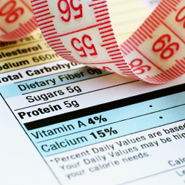Posted 22 November 2011
High sugar diet of mums-to-be linked to larger babies and childhood obesity
Consuming too many high sugar and high GI foods like white bread and fruit juice during pregnancy can increase the chances of giving birth to a larger baby, according to study findings. And with recent international studies linking higher birth weight to later childhood obesity, researchers are asking mums-to-be to watch their weight before and during pregnancy.
“Mums-to-be should optimise their weight before and during pregnancy because their weight affects blood sugar levels which in turn can cause overgrowth of the baby in the womb,” says Fionnuala McAuliffe, Professor of Obstetrics and Gynaecology at UCD School of Medicine & Medical Science and the National Maternity Hospital, Holles Street, Dublin, who led the study.
The findings published online in the European Journal of Obstetrics, Gynecology and Reproductive Biology show that even small variations in blood sugar levels during pregnancy can influence the growth of the baby in the womb.
The study by UCD researchers, funded by the Health Research Board in Ireland, observed 479 healthy mother and infant pairs attending the National Maternity Hospital, Holles Street, Dublin.
According to the findings, women with blood sugar concentrations at the upper end of the normal scale at 28 weeks of pregnancy were 3.5 times more likely to give birth to babies weighing over 9 pounds and 15 ounces (4500g) than those women with the lowest levels of blood sugar.
The average weight of a newborn baby is between 6 and 8 pounds. Babies born above 9 pounds and 15 ounces (4,500 grams) are considered larger babies.
“To optimise their weight mums-to-be should avoid too many high sugar foods such as white bread, cakes, soft drinks, fruit juices, and take regular exercise,” says Professor McAuliffe.
The study examined the association between maternal blood sugar levels throughout pregnancy and the growth of the baby in the womb, and the characteristics of the baby after birth.
“When the babies were born, we measured their weight, length, head circumference, and the level of cord blood glucose. The findings show that mother’s blood sugar levels influenced birth weight, but not the length or head size of the baby,” concludes Dr Jennifer Walsh who co-authored the study.
The researchers caution that the study findings do not suggest that all babies born above 9 pounds and 15 ounces (4500g) will suffer from childhood obesity.
Mr Enda Connolly, Chief Executive of the health Research Board who funded the research said:
”Excellent health research, like that conducted by Professor McAuliffe and her team has the capacity to improve our health as individuals and the health of the population at large.”
“It can also make a vital contribution to support decision making by policy makers and relevant practitioners. We would hope that quality research like this might contribute, for example, to helping the Minister for Health to bring a wholly integrated approach to tackling problem of obesity. By 2014, we plan to commit 45% of our funding into the general area of health services research and population health research in order to meet the strategic needs of the health system.
About blood sugar levels
In the study, the overall spread of mothers’ sugars was within a narrow range, however even small variations within the normal range were shown to influence baby’s growth.
Eating low sugar / low GI foods can result in maintenance of sugar levels at the lower range of normal and eating high sugar / high GI foods causes sugar levels to move to the upper ranges or normal.
The average pregnancy sugar levels in the study were 4.4 mmol/L; the lower range of normal were less than 4.2 mmol/L; and the higher range of normal were above 4.7 mmol/L
Obesity in Ireland
A study of obesity levels in Ireland published in April 2011 reported that obesity among women has reached 21%, while obesity among men has reached almost 26%.
Scientific paper
"The association of maternal and fetal glucose homeostasis with fetal adiposity and birthweight" published online in the European Journal of Obstetrics, Gynecology and Reproductive Biology. Authors: Jennifer M Walsh; Rhona Mahony; Jacinta Byrne; Michael Foley; and Fionnuala M McAuliffe - UCD School of Medicine and Medical Science, University College Dublin, Ireland; and the National Maternity Hospital, Dublin, Ireland.
(Produced by UCD University Relations)

